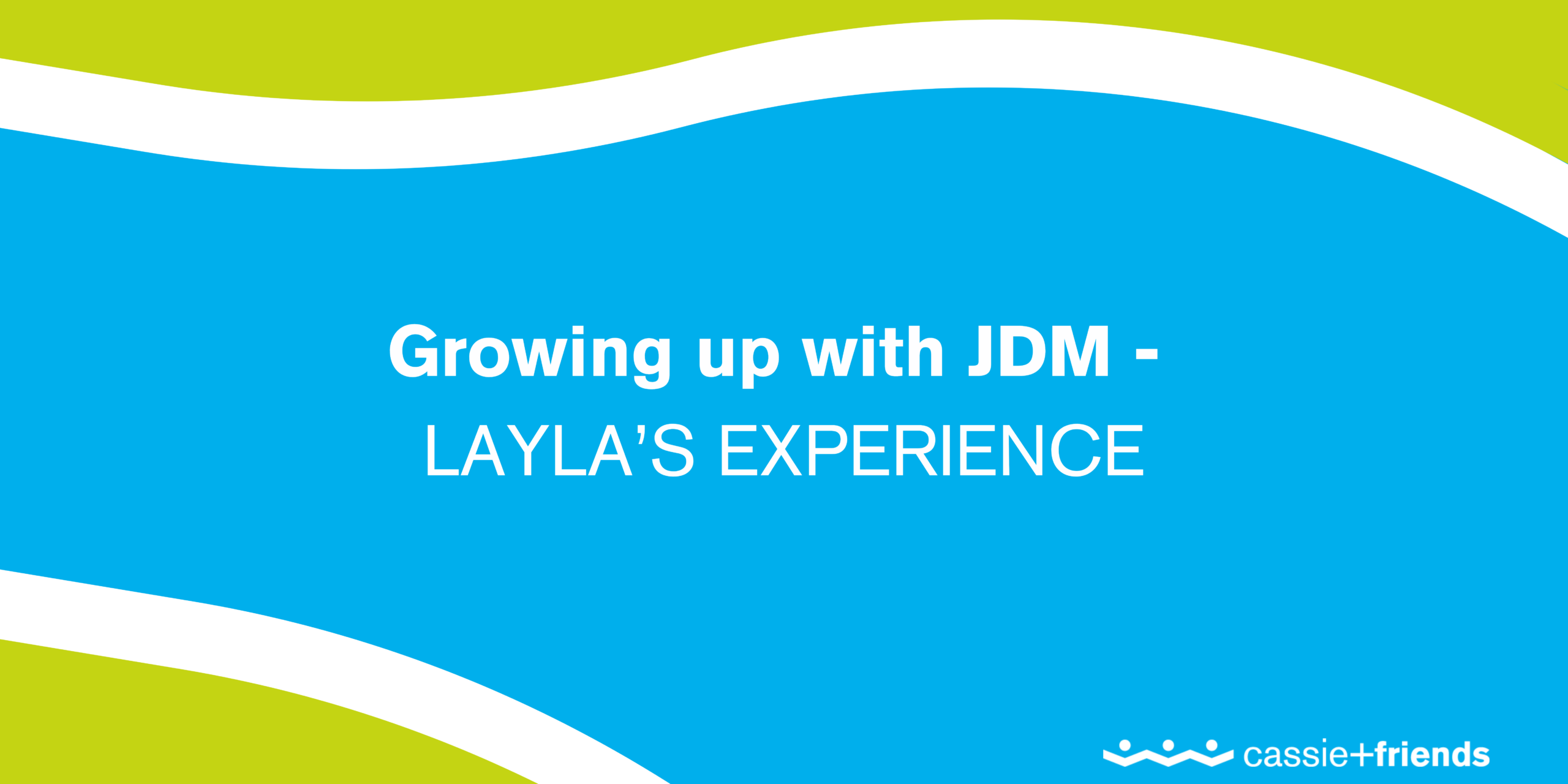
Growing up with JDM – Layla’s experience

My experience with the healthcare system started earlier than most.
I was diagnosed with Juvenile Dermatomyositis (JDM), a rare autoimmune disease that affects the muscles and skin, and since then, the Montreal Children’s Hospital has been a constant part of my life, a place where I’ve had many appointments, treatments, and moments that shaped both my health journey and who I am today.
My name is Layla Olivieri. I’m 18 years old, and this is my story.
At 15 months old, my behavior began to change. I was a lively and agile baby, walking around, picking things up, and doing the usual growing baby activities. But then I started acting differently. I began wanting to be carried around rather than walking, and I preferred to be given things instead of reaching for them myself even if they were in my range. This shift in behavior was so unlike me that it caught the attention of my aunt, who mentioned to my mom that something didn’t seem quite right. There are theories behind why I started acting up, but I won’t get into that.
My mom took me to my family doctor, Dr. Melchik, who initially thought it might be a neurological issue. This led to a referral to a neurologist, who gave me puzzles to solve to see if I was struggling with cognitive tasks. The puzzles had five levels, and the neurologist mentioned that the last three levels were never opened because no child had ever passed the first two. For me, on the other hand, she opened for the first time those last three levels and I passed them all effortlessly. This clearly indicated that it wasn’t a neurological problem, which left us still searching for an answer.
Dr. Melchik, persistent as ever, continued looking for answers. One night at 10 PM, she called my mom and said she thought she had figured it out. She referred me to the rheumatology department at the Montreal Children’s Hospital, where my soon-to-be doctor, Dr. Campillo quickly examined my nails.
Within 15 minutes, she diagnosed me with Juvenile Dermatomyositis, and I was officially diagnosed at 18 months old. Growing up with a chronic illness hasn’t always been easy, but the care and support I had received at the hospital made it seem like it wasn’t all so bad.
As a child, I didn’t fully understand what I had, I just knew something was wrong with me, from the hospital visits to the medications, they were just part of my normal.
Part of that experience included having to get MRIs done when I was little. I did four of them, two while I was asleep under anesthesia, and two while I was awake. My first one was when I was 2 years old, and the second when I was about 4 years old. The other two happened when I was a bit older, but still under the age of 9. MRIs weren’t something I had often because they’re delicate to the body, but they were important for checking how I was progressing with my JDM, and it was during one of the first ones that they had discovered that I had a cyst.
The experience itself was strange and confusing for me at the time. I had to lie completely still and be sent into this huge machine that looked like a giant digital camera, and I’d slide into what looked like the lens. At the beginning, my dad would stand at the head of the machine with me and hold my head, so I knew he was there and that I wasn’t alone. It wasn’t easy, having to stay perfectly still for nearly an hour, surrounded by faint lighting and without anyone next to me. But my parents always found ways to make it a little easier: after every MRI, they would take me to Toys”R”Us to pick out a toy of my choosing.
Because of that, I never really saw MRIs as something bad, just something that had to be done, that asked me to be strong, patient, and most importantly, calm. Was I scared? Yeah, absolutely. But I found reassurance and trust in the people who were taking care of me, and that made all the difference.
As I got a bit older, there was a time where I began to ask myself, why me? Why did I have to be the one going through this? Why was I on so much medication? Why did I need infusions, needles, and appointments that other kids didn’t? Why did I have bumps on me?
I was never someone who felt self-conscious growing up, but I always questioned why I had to be the one who looked swollen and puffy, all because of “prednisone” which is a steroid that has the effect of swelling up the body. I didn’t have the words for it, but I felt different. I remember wondering if people were judging me. In gym class, I was often one of the last kids picked for teams. Maybe it was because of how I looked, or maybe it was because I couldn’t always keep up physically, but either way, it still marked me. Still, I never stopped trying. I kept showing up, kept doing my best, and gave it my all. Even through all that, I was lucky to have incredible friends who never treated me differently.
There are so many pictures of me from that time that I still can’t stand to look at. It changed how I looked, and for a long time, how I saw myself. It wasn’t until I was about 14, when the effects fully wore off, that I finally started to like photos of myself.
But through all of this, the Montreal Children’s Hospital never made me feel alone. The doctors and nurses took time to explain things to me, to reassure me. They treated me with kindness, made me laugh, and helped me feel strong even when I didn’t. They reminded me that I was more than just a diagnosis.
The Children’s Hospital was an important place for me, and to be honest, I feel a little sad knowing I’ve outgrown it. As strange as it might sound, it was a place filled with kindness, support, and people who genuinely cared, and that made all the difference.
There were days I’d be there from 7 in the morning until 6 in the evening, transitioning from the daytime nurses to the nighttime ones. It all started at the old hospital, where I spent a lot of time in the Medical Day area. Nurses like Sue, Anna, Charlene, and Lina took care of me, and they’re people I’ll never forget. Anna, especially, had what I called a “magic touch” when it came to starting my IVIG treatments. She always got it on the first try. Just knowing that part of the day would go smoothly already made everything feel a bit easier.
Even beyond the nurses, there were incredible support staff like Julie, who made every visit feel a little less like a “hospital” day. She always checked in to see how I was doing, if I wanted to talk, or play games, and I’ll never forget the time we made pretzels in the room. That day didn’t feel like I was in a hospital at all, it felt like I was just a kid having fun.
When Medical Day would close and I was moved into the evening section, the nighttime nurses were just as wonderful. Even though by that point I was tired and just wanted to go home, they always managed to lift my mood and help me end the day with a smile.
In addition to managing my JDM, I faced other health challenges, such as a cyst in my right lower abdomen. It was about the size of a mozzarella cheese ball and was discovered after my first MRI. For a long time, it didn’t cause any issues, but by fifth grade, it started to affect me during physical activity. Whenever I would run or exert myself, I would experience sharp pain in my abdomen, making it difficult to keep up with everyone else. I noticed the discomfort at the start of the school year and, after repeated hospital visits, it was discovered that the cyst had started bleeding internally, which caused the pain to get progressively worse. I was 11 years old when it was surgically removed in the summer of 2018. The recovery wasn’t easy, and for a couple of days, I felt like I would never recover, but with the support of my parents and cousins, I managed to make a speedy recovery. I still have a faint scar on my right lower abdomen, which is barely noticeable unless I point it out.
My first surgery, however, happened when I was just 21 months old. I was diagnosed with a strain of meningitis, and I had a green pus-filled bubble on the right side of my collarbone, next to my neck. It was my first experience with surgery, and it marked the beginning of my ongoing relationship with healthcare.
As I got older and started to understand more about my condition, I never really believed that I’d ever be off treatment. In my mind, going to the hospital every few weeks for treatment was just something that would always be a part of my life, like a routine check-in I had grown used to.
But then one day, during what I thought was a regular appointment, my doctor came in and we went through the usual topics of how I was feeling and overall health updates. And then, right at the end of our conversation, she looked at me and said, “Well, it seems like you’re doing so well that we’ll be able to take you off treatment.”
At that moment, it felt like the world just stopped. Everything around me went silent, and I just stared at her, completely stunned. My mom immediately dropped everything and said, “What?” We were both in complete shock. Those were the words we never expected to hear: “You’re done treatment.”
After 14 years, my final treatment day took place when I was 16, on August 9th, 2022. The Medical Day team decorated my usual spot, the bed right in front of the nurses’ station, where I always liked to be. They transformed it into a Vegas-themed celebration room. That day, it wasn’t just a hospital bed, it became a space filled with joy, love, and memories.
People who had cared for me since I was diagnosed came by to share their thoughts, their hugs, their well-wishes. It was more than I ever expected and just one of the many moments that showed how deeply the Montreal Children’s Hospital had marked my life, not just as a patient, but as a person.
But even after that celebration, the journey wasn’t over. Once I was off treatment, I actually started getting sick more often. At first, it was confusing, but then I realized that my situation is exactly like how babies get sick a lot because their immune systems are building up. In a way, I was like a 17-year-old baby. For so long, my immune system had support from medications and treatments, and now it had to learn to work on its own.
Even though I was officially off treatment, I still had medication to take. I’m on a medication called Neoral, a cyclosporin, which I need to take every morning and night. That routine has stayed the same for as long as I can remember, but the good news is that my dose is much smaller now compared to when I was younger, and eventually, I’ll be off it completely. Another part of my routine is taking methotrexate (MTX) once a week, followed 24 hours later by leucovorin to help with the side effects. When I was younger, MTX wasn’t taken orally like it is now. It was given to me through an injection once a week, and at first, I had to go to the CLSC for a nurse to do it. I used to dread Thursdays because I knew it meant getting the needle, and it made me so anxious that I’d even feel sick just thinking about it. I convinced my parents to switch it to Fridays, but eventually I started dreading Fridays too. My mom tried to make it easier by learning how to give me the injections at home after my nurse, Charlene, taught her the proper methods but even then, I found myself skipping doses or “forgetting” on purpose. I’m not saying that skipping medication is a good idea, it’s not, but I learned how important it is to speak up when something doesn’t feel right. After missing too many doses, my mom encouraged me to talk to Charlene about it. She helped find a solution that worked better for me which waa switching to the pill form. Since then, I’ve been able to stick to my doses, taking my MTX on Thursdays through Fridays and following it up with leucovorin the next day. That experience taught me that it’s okay to advocate for yourself, even with things that seem small. It can make a huge difference.
My last visit before turning 18 came with a lot of emotions. I was really happy to hear that things were still going well with my health, and knowing that I’d be moving on to adult care with a new team gave me some reassurance. But when I was walking out of the hospital that day, I got a bit emotional. The Children’s had been a familiar place for so many years of my life. Saying goodbye felt like closing a chapter that had been part of me for a long time.
Of course, I’m glad to be getting better, that’s what we’d always hoped for. But even with the tough moments, I’ll always appreciate the people who made those long days easier, who helped me through it all in big and small ways. The Children’s may not be part of my life anymore, but it’ll always hold a special place in my heart.
It took me a while to realize that having this disease was never something I could control and it wasn’t my fault. I’ve come to see that JDM has shaped a big part of who I am today. It’s taught me strength, resilience, and how to keep moving forward even when things feel hard.
Today, I’m 18 years old, living with Juvenile Dermatomyositis and while I’ll probably always have it, it’s a part of who I am. It’s shaped my journey, and instead of seeing it as a limitation, I’ve embraced it as something that has motivated me to grow and pursue the best version of myself.
Living with JDM has made me obsessed with self-care and vigilant about what I put into my body. I’m passionate about maintaining an active lifestyle; I work out regularly, I am a figure skater and I stay engaged in activities that keep me fit. Despite it all, I’m able to do the things other kids my age can do, and I’ve never let my disease hold me back. If anything, it’s pushed me to become stronger and more determined.
I’m now a Health Science student, pursuing my dream of becoming a doctor. I want to give back for all the care I’ve received and make a difference in the lives of others, just like those who helped me shape my life for the better.
I hope that by speaking openly about my experience, someone else out there will feel a little more understood and a little less alone.
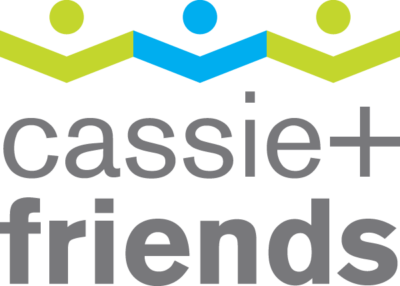
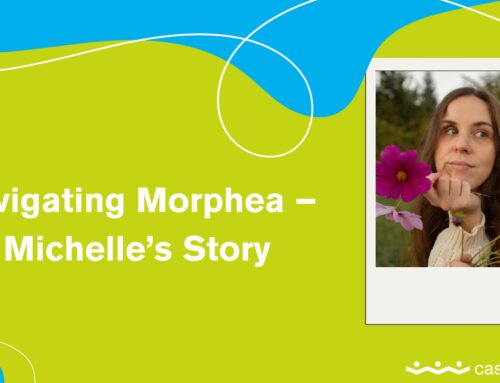
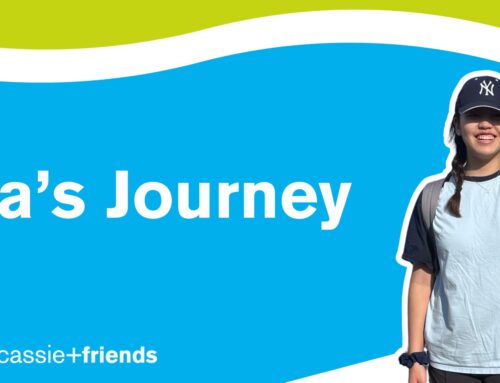

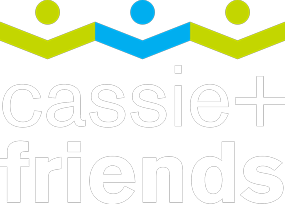



Leave A Comment